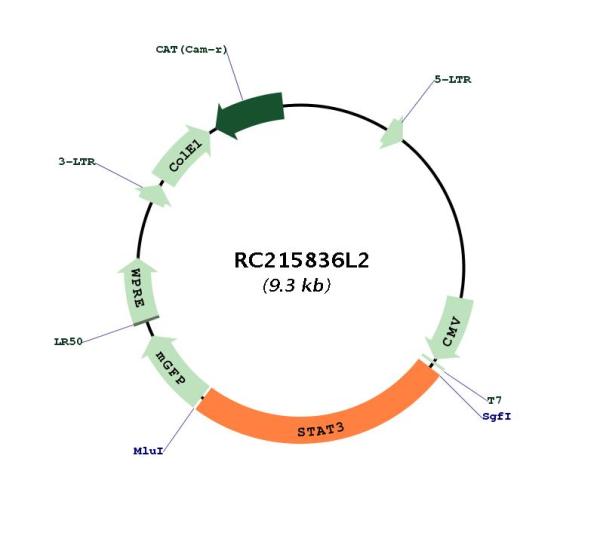STAT3 (NM_139276) Human Tagged Lenti ORF Clone
CAT#: RC215836L2
- LentiORF®
Lenti ORF clone of Human signal transducer and activator of transcription 3 (acute-phase response factor) (STAT3), transcript variant 1, mGFP tagged
"NM_139276" in other vectors (6)
USD 365.00
Specifications
| Product Data | |
| Type | Human Tagged ORF Clone |
| Tag | mGFP |
| Symbol | STAT3 |
| Synonyms | ADMIO; ADMIO1; APRF; HIES |
| Vector | pLenti-C-mGFP |
| E. coli Selection | Chloramphenicol (34 ug/mL) |
| Mammalian Cell Selection | None |
| Sequence Data |
The ORF insert of this clone is exactly the same as(RC215836).
|
| Restriction Sites |
SgfI-MluI
Cloning Scheme for this gene
Plasmid Map

|
| ACCN | NM_139276 |
| ORF Size | 2310 bp |
| OTI Disclaimer | Due to the inherent nature of this plasmid, standard methods to replicate additional amounts of DNA in E. coli are highly likely to result in mutations and/or rearrangements. Therefore, OriGene does not guarantee the capability to replicate this plasmid DNA. Additional amounts of DNA can be purchased from OriGene with batch-specific, full-sequence verification at a reduced cost. Please contact our customer care team at custsupport@origene.com or by calling 301.340.3188 option 3 for pricing and delivery. The molecular sequence of this clone aligns with the gene accession number as a point of reference only. However, individual transcript sequences of the same gene can differ through naturally occurring variations (e.g. polymorphisms), each with its own valid existence. This clone is substantially in agreement with the reference, but a complete review of all prevailing variants is recommended prior to use. More info |
| OTI Annotation | This clone was engineered to express the complete ORF with an expression tag. Expression varies depending on the nature of the gene. |
| Product Components | The ORF clone is ion-exchange column purified and shipped in a 2D barcoded Matrix tube containing 10ug of transfection-ready, dried plasmid DNA (reconstitute with 100 ul of water). |
| Reconstitution | 1. Centrifuge at 5,000xg for 5min. 2. Carefully open the tube and add 100ul of sterile water to dissolve the DNA. 3. Close the tube and incubate for 10 minutes at room temperature. 4. Briefly vortex the tube and then do a quick spin (less than 5000xg) to concentrate the liquid at the bottom. 5. Store the suspended plasmid at -20°C. The DNA is stable for at least one year from date of shipping when stored at -20°C. |
| Reference Data | |
| RefSeq | NM_139276.2 |
| RefSeq Size | 4978 bp |
| RefSeq ORF | 2313 bp |
| Locus ID | 6774 |
| UniProt ID | P40763 |
| Cytogenetics | 17q21.2 |
| Domains | SH2, STAT |
| Protein Families | Druggable Genome, Transcription Factors |
| Protein Pathways | Acute myeloid leukemia, Adipocytokine signaling pathway, Chemokine signaling pathway, Jak-STAT signaling pathway, Pancreatic cancer, Pathways in cancer |
| MW | 87.9 kDa |
| Gene Summary | The protein encoded by this gene is a member of the STAT protein family. In response to cytokines and growth factors, STAT family members are phosphorylated by the receptor associated kinases, and then form homo- or heterodimers that translocate to the cell nucleus where they act as transcription activators. This protein is activated through phosphorylation in response to various cytokines and growth factors including IFNs, EGF, IL5, IL6, HGF, LIF and BMP2. This protein mediates the expression of a variety of genes in response to cell stimuli, and thus plays a key role in many cellular processes such as cell growth and apoptosis. The small GTPase Rac1 has been shown to bind and regulate the activity of this protein. PIAS3 protein is a specific inhibitor of this protein. This gene also plays a role in regulating host response to viral and bacterial infections. Mutations in this gene are associated with infantile-onset multisystem autoimmune disease and hyper-immunoglobulin E syndrome. [provided by RefSeq, Aug 2020] |
Documents
| Product Manuals |
| FAQs |
| SDS |
Resources
Other Versions
| SKU | Description | Size | Price |
|---|---|---|---|
| RC215836 | STAT3 (Myc-DDK-tagged)-Human signal transducer and activator of transcription 3 (acute-phase response factor) (STAT3), transcript variant 1 |
USD 1,057.00 |
|
| RC215836L1 | Lenti ORF clone of Human signal transducer and activator of transcription 3 (acute-phase response factor) (STAT3), transcript variant 1, Myc-DDK-tagged |
USD 1,357.00 |
|
| RC215836L3 | Lenti ORF clone of Human signal transducer and activator of transcription 3 (acute-phase response factor) (STAT3), transcript variant 1, Myc-DDK-tagged |
USD 1,357.00 |
|
| RC215836L4 | Lenti ORF clone of Human signal transducer and activator of transcription 3 (acute-phase response factor) (STAT3), transcript variant 1, mGFP tagged |
USD 1,357.00 |
|
| RG215836 | STAT3 (tGFP-tagged) - Human signal transducer and activator of transcription 3 (acute-phase response factor) (STAT3), transcript variant 1 |
USD 1,257.00 |
|
| SC124165 | STAT3 (untagged)-Human signal transducer and activator of transcription 3 (acute-phase response factor) (STAT3), transcript variant 1 |
USD 1,059.00 |
{0} Product Review(s)
Be the first one to submit a review






























































































































































































































































 Germany
Germany
 Japan
Japan
 United Kingdom
United Kingdom
 China
China


